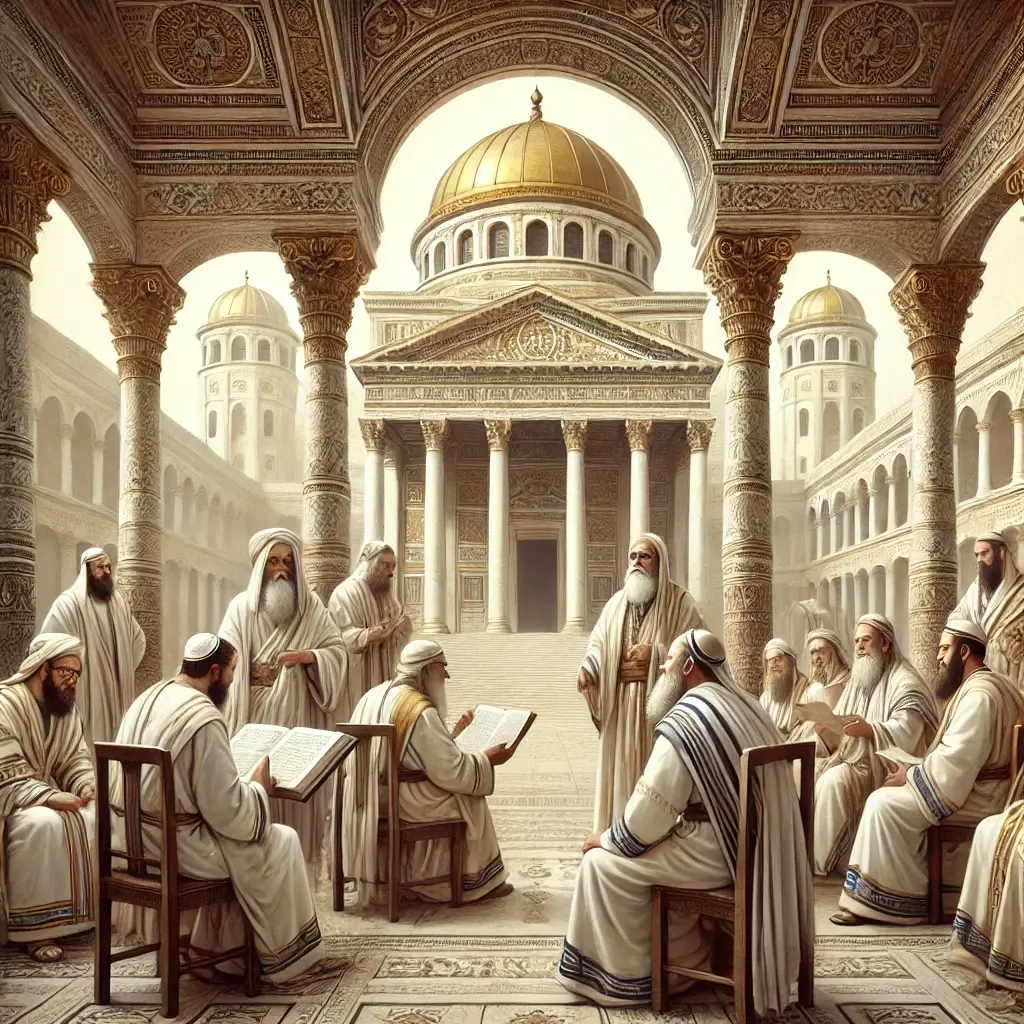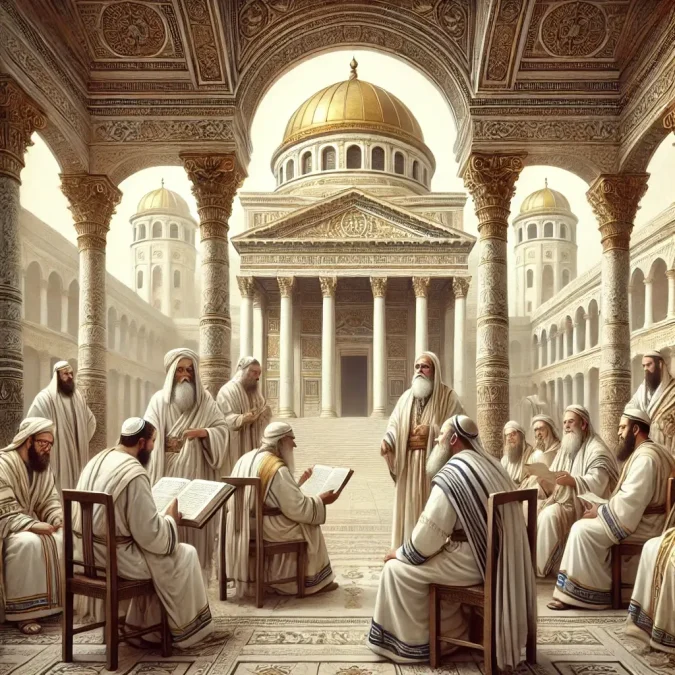
The Sadducees were one of the most prominent Jewish sects during the Second Temple period, playing a significant role in the religious, political, and social life of ancient Judea. Known for their aristocratic status and influence within the Temple hierarchy, the Sadducees were often in conflict with other Jewish groups, particularly the Pharisees and Essenes, due to their differing beliefs and practices. This article provides an in-depth exploration of the history, beliefs, and influence of the Sadducees, shedding light on their role in Jewish society and their impact on the development of religious thought during a crucial period in Jewish history.
The Origins and Historical Context of the Sadducees
The Sadducees emerged as a distinct group during the Second Temple period (516 BCE – 70 CE), a time marked by the return of the Jewish people from Babylonian exile and the rebuilding of the Temple in Jerusalem. This period saw the rise of various Jewish sects, each with its interpretation of Jewish law and its role in society.
The Second Temple and the Division of Jewish Society
The Second Temple period was characterized by significant religious and political upheaval, including the influence of Hellenism, the rule of the Hasmoneans, and later, Roman occupation. The Sadducees were primarily composed of the priestly aristocracy and wealthy families who held significant power within the Temple and the Sanhedrin, the highest Jewish council. Their influence was largely tied to their control of the Temple, which was the center of Jewish religious life.
The Relationship with the Hasmoneans and Romans
The Sadducees initially rose to prominence during the rule of the Hasmonean dynasty, which followed the Maccabean Revolt against the Seleucid Empire. They were closely aligned with the ruling class and benefited from their association with the Hasmonean rulers. Later, during the Roman occupation of Judea, the Sadducees maintained their power by cooperating with Roman authorities, which allowed them to retain their control over the Temple and its rituals.
Beliefs and Practices of the Sadducees
The Sadducees were known for their distinct theological beliefs, which often put them at odds with other Jewish sects, particularly the Pharisees. Their beliefs were characterized by a strict interpretation of the Torah and a rejection of many of the oral traditions and doctrines that were embraced by other groups.
The Rejection of Oral Tradition
Unlike the Pharisees, who believed in the authority of the Oral Torah—a body of interpretations and teachings that supplemented the written Torah—the Sadducees adhered strictly to the written law. They rejected the notion that the oral traditions held any divine authority, which led to significant theological disputes with the Pharisees. This strict adherence to the written law influenced their views on various religious practices, including ritual purity and sacrificial offerings.
Denial of the Resurrection and Afterlife
One of the most notable beliefs of the Sadducees was their denial of the resurrection of the dead and the existence of an afterlife. They believed that the soul did not survive after death and that there was no reward or punishment beyond the grave. This belief was in stark contrast to the Pharisees, who believed in the resurrection and the concept of an afterlife where individuals would be judged based on their deeds.
The Role of Free Will
The Sadducees also held distinct views on free will and divine intervention. They emphasized the importance of human free will and believed that individuals were responsible for their actions without any divine predestination. This belief contrasted with the Pharisaic view, which allowed for a combination of divine providence and human free will.
The Role of the Sadducees in the Temple and the Sanhedrin
The Sadducees held significant power within the Temple and were responsible for overseeing its rituals and sacrifices. Their control of the Temple priesthood allowed them to maintain their influence over Jewish religious life, particularly during major festivals such as Passover, Shavuot, and Sukkot.
The Temple Priesthood
As members of the priestly class, the Sadducees were responsible for performing the sacrificial rites and maintaining the daily operations of the Temple. Their authority over the Temple services gave them considerable power, as the Temple was the focal point of Jewish worship and identity. The Sadducees’ role in the priesthood also meant that they had control over the collection of tithes and other offerings, which further solidified their economic and social status.
Influence in the Sanhedrin
The Sanhedrin was the supreme judicial and legislative body of the Jewish people during the Second Temple period. The Sadducees, due to their aristocratic status, held significant influence within the Sanhedrin, particularly in matters related to Temple law and governance. However, their authority in the Sanhedrin was often challenged by the Pharisees, who had broader support among the common people and emphasized the application of the Oral Torah in legal matters.
Conflicts with Other Jewish Sects
The Sadducees were often in conflict with other Jewish sects, especially the Pharisees and Essenes. These conflicts were rooted in their differing interpretations of Jewish law, theology, and their roles in society.
The Sadducees vs. the Pharisees
The rivalry between the Sadducees and the Pharisees was one of the defining features of Jewish society during the Second Temple period. The Pharisees, who were more popular among the common people, emphasized the importance of the Oral Torah and believed in concepts such as the resurrection and the afterlife. The Sadducees, on the other hand, rejected these beliefs and viewed the Pharisees’ emphasis on oral traditions as a deviation from the true teachings of the Torah.
The Sadducees and the Essenes
The Essenes were another Jewish sect that emerged during the Second Temple period. The Essenes were known for their ascetic lifestyle and their separation from mainstream Jewish society, which they viewed as corrupt. While there is limited evidence of direct conflict between the Sadducees and the Essenes, their differing approaches to religious practice and community life highlight the diversity of Jewish thought during this period. The Essenes’ focus on purity and communal living stood in stark contrast to the Sadducees’ involvement in the Temple hierarchy and their cooperation with political rulers.
The Decline and Disappearance of the Sadducees
The Sadducees’ power and influence were closely tied to the existence of the Second Temple. With the destruction of the Temple by the Romans in 70 CE, the Sadducees lost their primary base of power, leading to their decline and eventual disappearance from Jewish history.
The Destruction of the Second Temple
The First Jewish-Roman War (66-73 CE) was a major turning point in Jewish history. The destruction of the Second Temple by the Romans in 70 CE not only marked the end of the Temple-centered worship that the Sadducees had controlled but also led to significant changes in Jewish religious practice. Without the Temple, the Sadducees lost their authority and their role in Jewish society, as the sacrificial system they oversaw could no longer be performed.
The Rise of Rabbinic Judaism
In the aftermath of the Temple’s destruction, Rabbinic Judaism emerged as the dominant form of Jewish religious practice. The Pharisees, who had emphasized the importance of the Oral Torah and the study of Jewish law, were able to adapt to the new reality of a Temple-less Judaism. The Sadducees, whose authority was based on the Temple and the priesthood, were unable to make this transition, leading to their decline and disappearance as a distinct group.
The Legacy of the Sadducees
The Sadducees played a significant role in shaping the religious and political landscape of ancient Judea. Their influence within the Temple and the Sanhedrin, as well as their conflicts with other Jewish sects, had a lasting impact on Jewish history and thought.
Contributions to Jewish Religious Life
Despite their eventual decline, the Sadducees made important contributions to Jewish religious life during the Second Temple period. Their emphasis on the written law and their role in maintaining the Temple rituals helped preserve the centrality of the Torah and the Temple in Jewish worship. Their interactions with other sects also contributed to the development of Jewish theological debates, which continue to influence Jewish thought to this day.
Influence on Early Christianity
The Sadducees are also mentioned in the New Testament, where they are often depicted in conflict with Jesus and the early Christian movement. Their rejection of the resurrection and their close ties to the Temple made them adversaries of Jesus’ teachings, which emphasized the coming of the Kingdom of God and the resurrection of the dead. The Sadducees’ interactions with Jesus and the early Christians provide valuable insight into the religious dynamics of Judea during the 1st century CE.
Conclusion: The Enduring Significance of the Sadducees
The Sadducees were a powerful and influential sect during one of the most critical periods in Jewish history. Their role in the Temple, their conflicts with other Jewish sects, and their decline following the destruction of the Second Temple all contributed to the shaping of Jewish religious thought and practice. While the Sadducees as a group did not survive beyond the Second Temple period, their legacy lives on in the historical and religious narratives of Judaism and Christianity.
The story of the Sadducees serves as a reminder of the diversity of thought within Judaism during the Second Temple period and the complexities of religious authority and practice. Their strict adherence to the written law and their emphasis on free will continue to be topics of interest for scholars and students of Jewish history, providing a window into the rich tapestry of beliefs and practices that characterized ancient Judea.

Did the Sadducees actually operate the selling of the animals of sacrifice, set prices, taxes and change currencies in the court of the Gentiles.